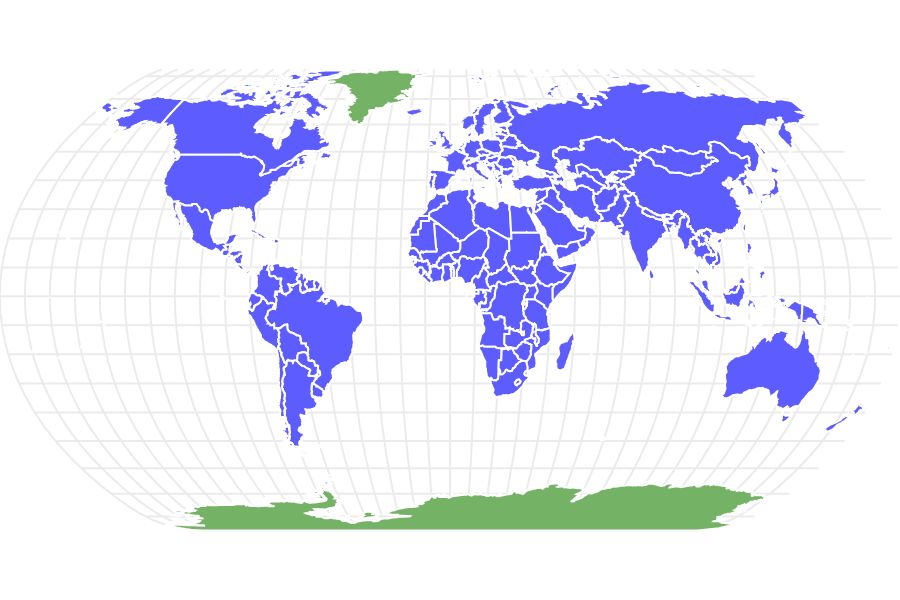Eel
Eels can be a mere few inches long to 13 feet!
Advertisement
Eel Scientific Classification
Read our Complete Guide to Classification of Animals.
Eel Conservation Status
Eel Facts
- Prey
- Smaller fish, invertebrates, crustaceans, shrimp, crabs, sea urchins
- Group Behavior
- Solitary/Group
- Fun Fact
- Eels can be a mere few inches long to 13 feet!
- Estimated Population Size
- Unknown
- Biggest Threat
- Human consumption of freshwater eels
- Most Distinctive Feature
- Snakelike appearance
- Gestation Period
- Unknown
- Habitat
- Ocean, river, freshwater
- Predators
- Larger eels, larger fish, fish-eating birds, and (for freshwater eels) humans
- Diet
- Carnivore
- Type
- Anguilliform, Actinopterygii, Teleost
- Common Name
- Eel
- Number Of Species
- 800
The body of an eel has a slimy coating, hence the phrase, “Slippery as an eel.”
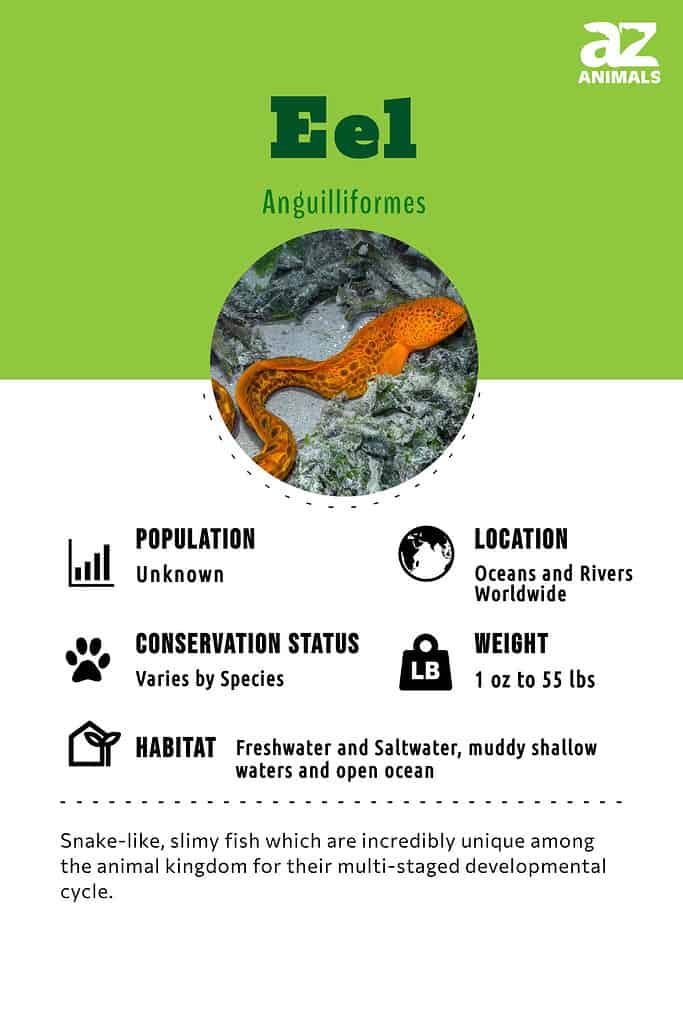
The most dangerous eel species is the conger. Although these fish are very snakelike in appearance, they are actually fish. They are ray-finned fishes of the order Anguilliformes, with the term “eel” referring to snake-like fish such as electric, ribbon, wolf eels, lampreys, and morays along with true eels for a total of 800 species. The eel fish can be anywhere from a few inches to 13 feet or more in length. A few freshwater species have become endangered due to human over-consumption.
5 Incredible Eel Facts!
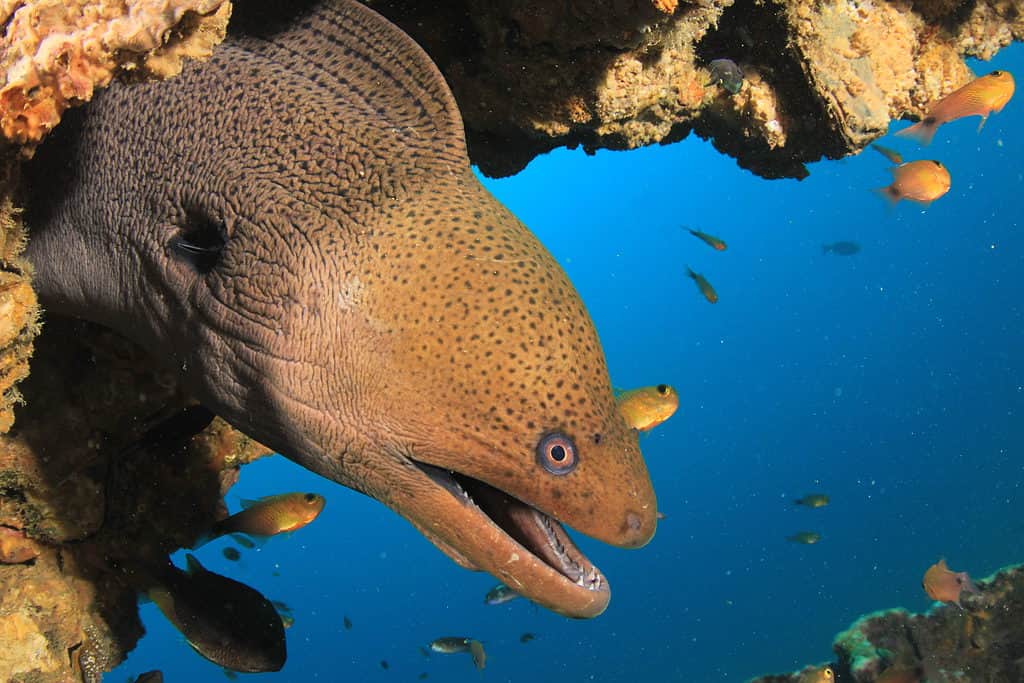
Morays are the largest species of eel.
©Rich Carey/Shutterstock.com
- Eel fish can swim backward.
- The slender giant moray is the longest species at 13 feet.
- The largest eel ever recorded was a European conger that reportedly reached 350 pounds!
- The gulper (pelican) has an enormous mouth resembling a pelican’s pouch.
- Onejaws have no upper jaw but unusually large mouths, and none of the 15 species exceed 7 inches in length.
Classification and Scientific Name
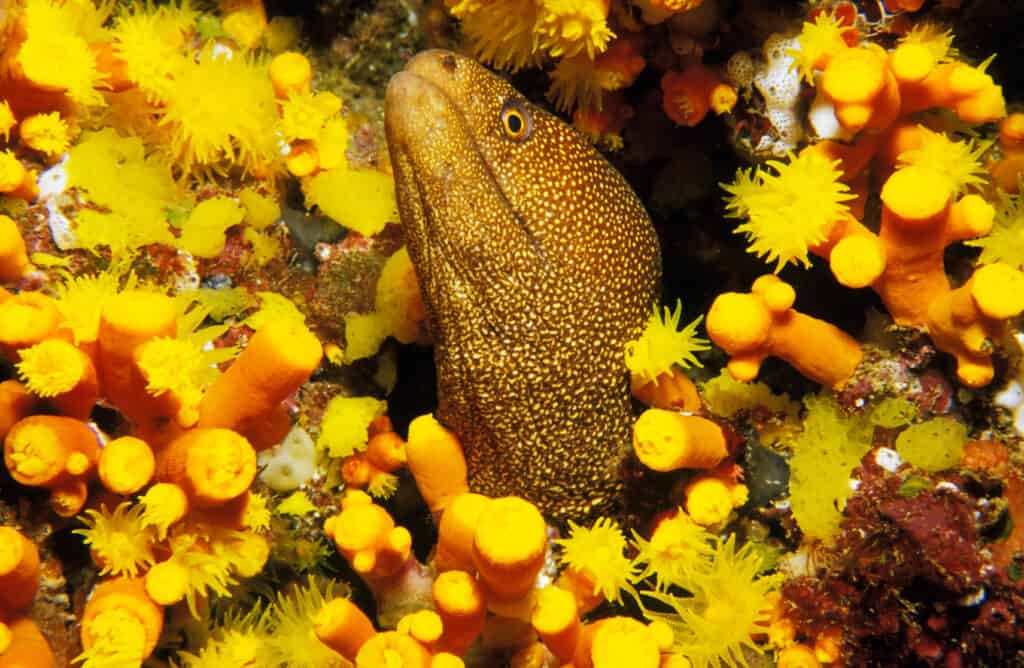
Eels all belong to the Anguillifomes order of classification.
©iStock.com/Miguel Angelo Silva
Anguilliforms include freshwater as well as saltwater fish such as marine morays. There are 19 families, 111 genera, and approximately 800 species. They are further classed from the Phylum Chordata into the Actinopterygii Class. They are also Teleosts, or members of the infraclass Teleostei, which contains 96% of all currently existing fish species.
Conger or true eels (Conger conger) are members of the family Congridae which includes both congers and garden eels. Only members of the order Anguilliformes are true eels. The electric eel is not a true eel but a knife fish, related to carp and catfish, and a member of the order Gymnotiformes and the genus Electrophorus. It is also an air breather and, unlike true species, lives in freshwater.
The wolf eel‘s scientific name is Anarrhichthys ocellatus. The scientific name of the ribbon eel, also known as the leaf-nosed moray or bernis, is Rhinomuraena quaesita. Morays are of the family Muraenidae; however, the ribbon eel is sometimes classed in its own family Rhinomuraenidae. Lampreys are jawless fish of the class Hyperoartia, order Petromyzontiformes, and superclass Cyclostomata.
Evolution
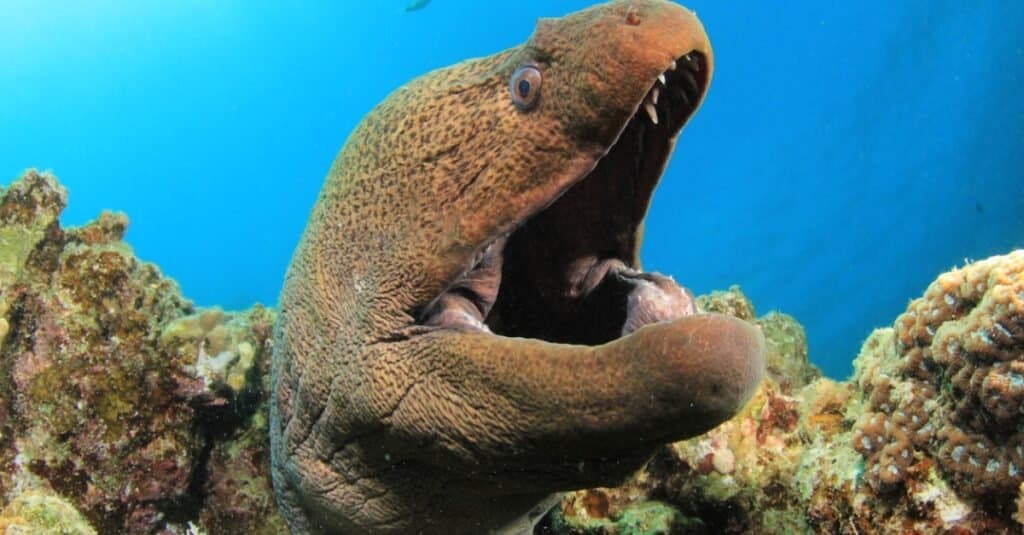
Eels have evolved many different distinct characteristics in order to survive
©Rich Carey/Shutterstock.com
The first ancient ancestors of modern eels first appeared sometime around 140 million years ago. For a long time, the intricacies of how these creatures developed into the complex array of species we find around the globe today were a complete mystery to the scientists who studied them. However, with the vast advancements made in genetic coding, many of the eel’s secrets have been revealed.
While examining the DNA of American and European eels, researchers found that it was around 2.5-3.5 million years ago during the formation of the isthmus of Panama between North and South America that these two major groups of eels became separate from one another and began to develop their own distinct traits.
Appearance
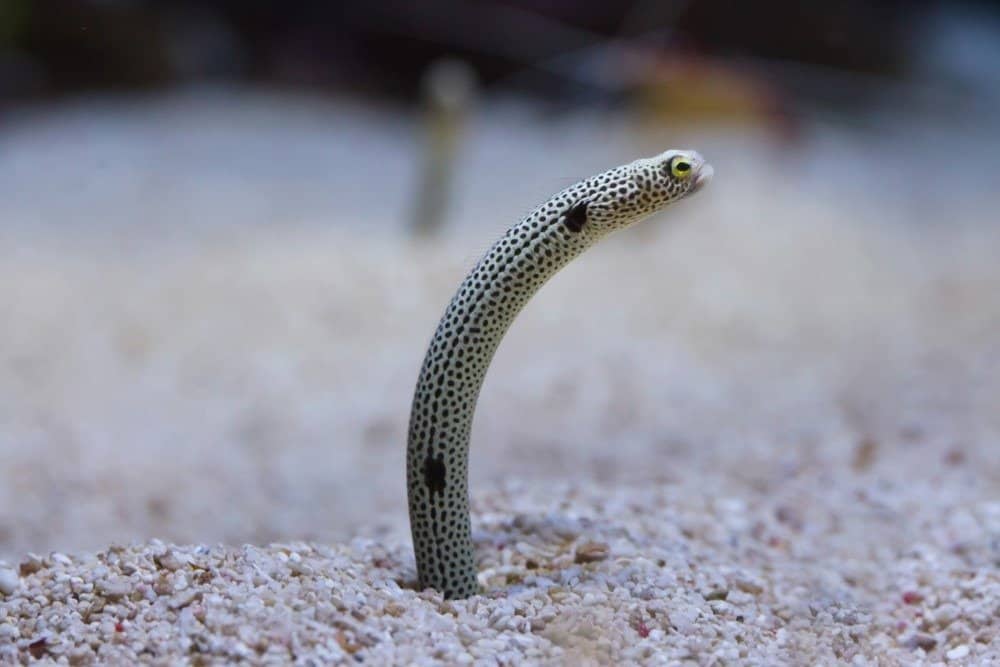
Garden eels are amongst the tiniest types of eel.
©Vladimir Wrangel/Shutterstock.com
Different species vary in appearance by their length, color, mouth, and fins. For example, wolf eels are a species of wolffish that differs from true species with their paired gill slits and pectoral fins, while the lamprey has a toothed, funnel-shaped mouth. However, all have long snakelike or wormlike bodies that end in a modified tail fin that is really the fusion of the dorsal and anal fins.
They are also characterized by strong jaws and small, sharp teeth. These fish have no pelvic fins and many lack pectoral fins. The larvae are called glass eels, so named due to their transparency. The term does not refer to a fish species but the larval stage refers to the fish’s life stage after hatching and up to adulthood.
Distribution, Population, and Habitat
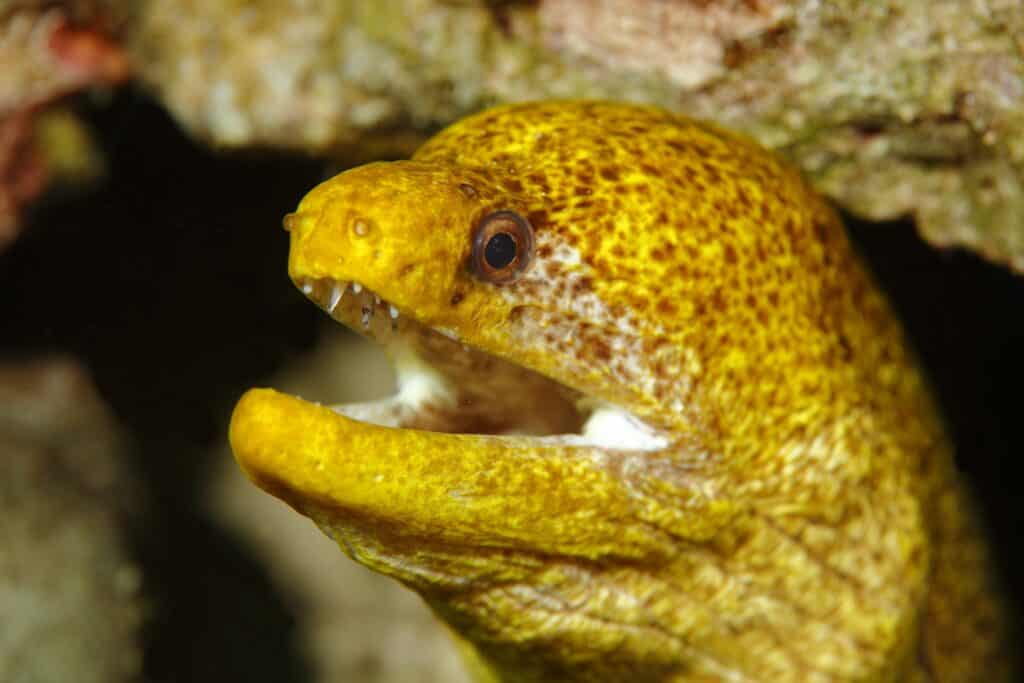
The precise number of eels living in the world’s waters today is not known.
©Thierry Eidenweil/Shutterstock.com
The population of all 800 species worldwide is unknown. It is possible for them to inhabit a small or large range because each species has its own unique distribution. Eel fish can inhabit many types of habitats including oceans, rivers, lakes, and smaller bodies of water. They live deep underwater so as to burrow into the floor or find shelter in coral reefs, rock fissures, and muddy or pebbly water. Fish of the family Anguillidae typically inhabit freshwater.
Predators and Prey
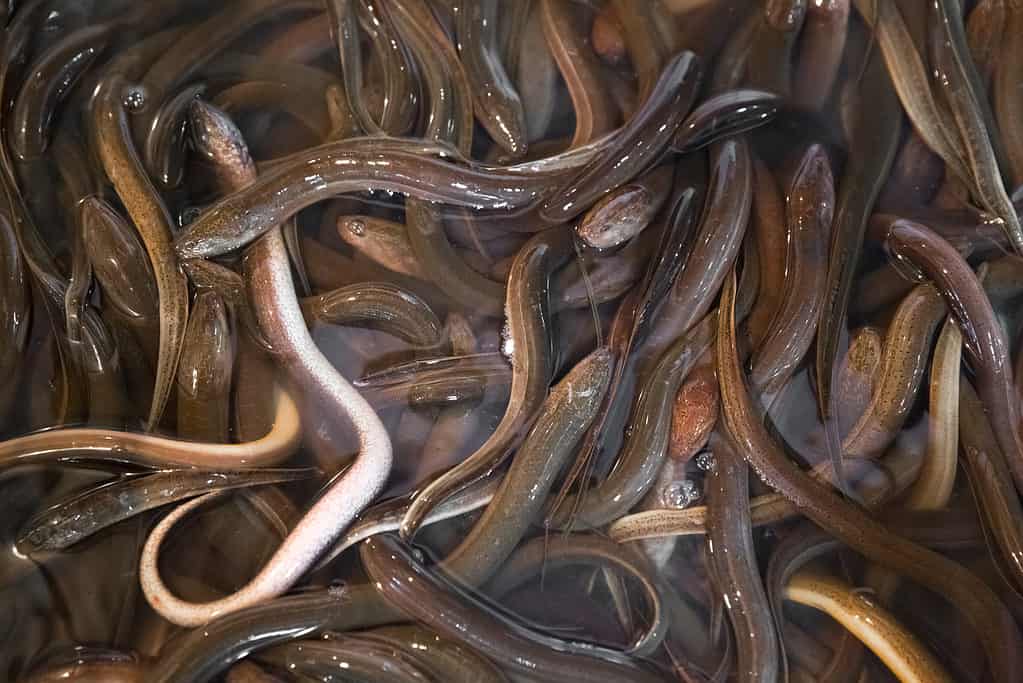
Humans are the biggest threat to most types of eel.
©Valentin Ayupov/Shutterstock.com
American and European species are threatened by habitat destruction and climate change. Overconsumption by humans is responsible for endangering American and Japanese species and critically endangering the European species.
What eats eels?
There are several types of predators depending on the species and its size. Generally, larger fish, seabirds (including herons and storks), and mammals (including raccoons and humans), eat these fish.
What do eels eat?
These are primarily predatory fish with carnivorous diets, sometimes cannibalistic. They eat smaller fish, invertebrates, crustaceans, shrimp, crabs, sea urchins. Those in freshwater habitats also consume insect larvae, including that mosquitos, and worms. Freshwater species eat carrion in addition to live prey.
Reproduction and Lifespan
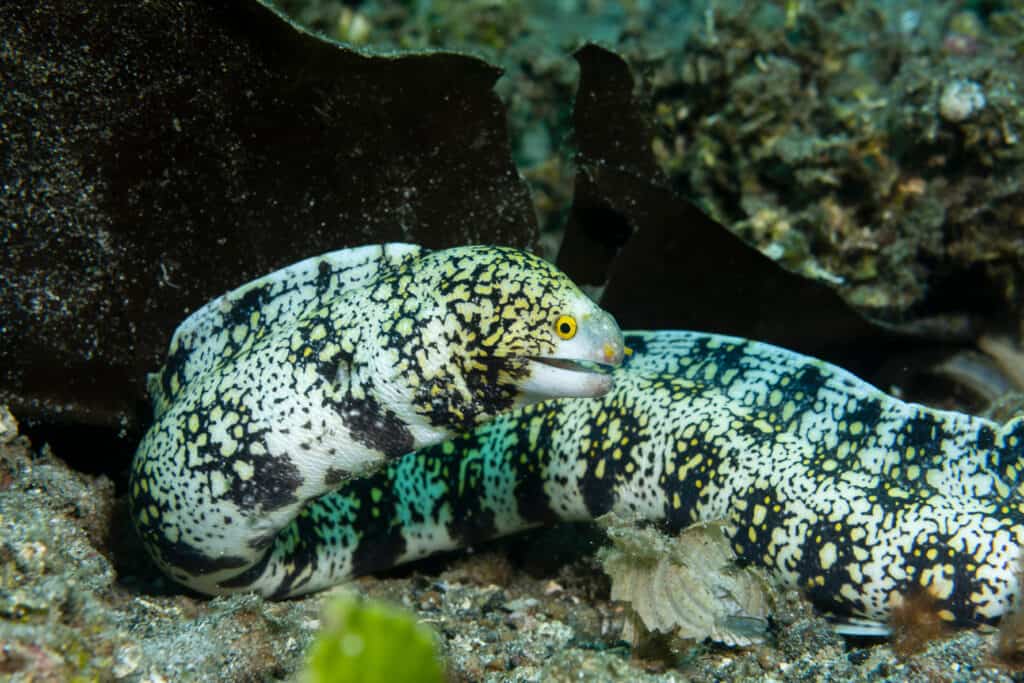
Most species of eel live considerably longer lives than other fish.
©Kaschibo/Shutterstock.com
These fish reproduce with a large mating group in which they dance around each other to spawn, after which the eggs hatch into larvae, called glass eels. After the adults spawn, they die. Freshwater species will go to marine waters to mate. However, not much else is known about their reproduction.
The lifespan of these fish generally ranges from 32-88 years depending on the species. On the low end, the short-finned species lives 32 years. The American species lives 43 years and the European species is the longest-living at 88 years.
Eel in Fishing and Cooking
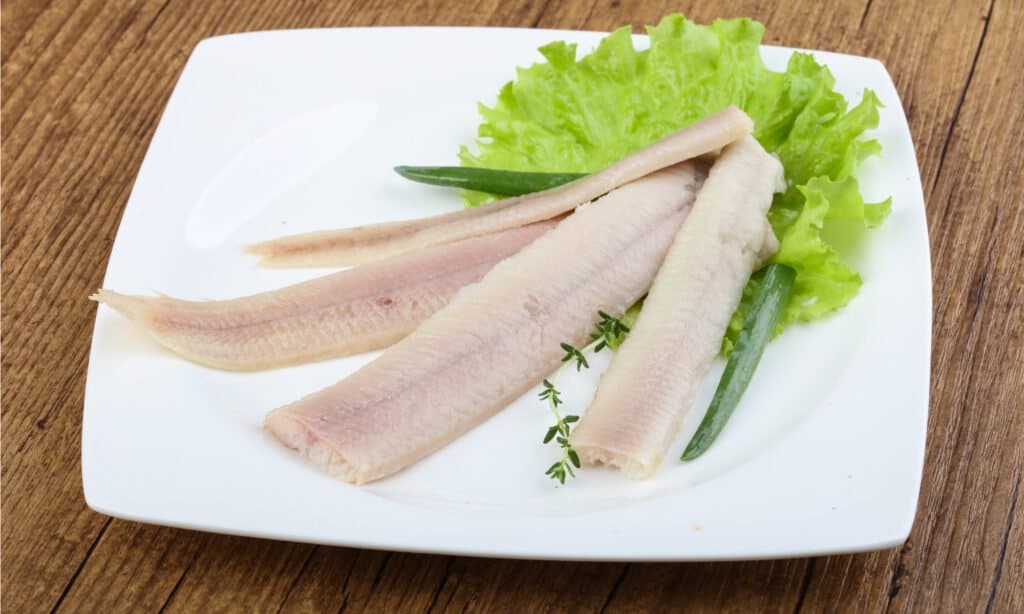
Eels are incorporated in many different delicious dishes around the world.
©Andrey Starostin/Shutterstock.com
The main commercial types and the scientific names of each species are the American (Anguilla rostrata), European (Anguilla anguilla), Japanese (Anguilla japonica), and the short-finned eel (Anguilla australis). All of them are freshwater fish (family Anguillidae). A popular saltwater species in Japanese cuisine is the white-spotted conger (Conger myriaster).
Population
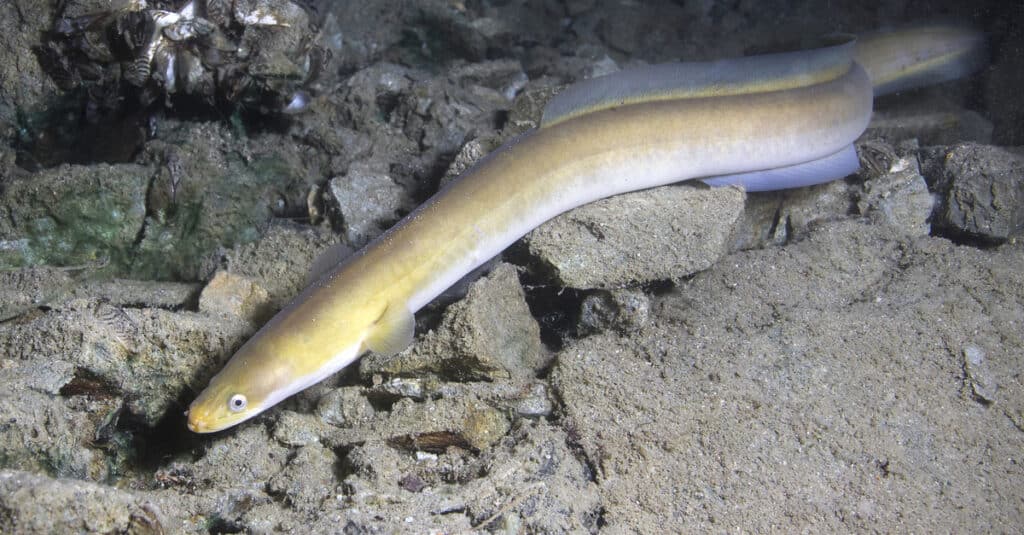
The European Eel is considered to be Critically Endangered.
©Rostislav Stefanek/Shutterstock.com
Determining this fish’s population is dependent on each species, as a worldwide assessment of all 800 species has not been done. The IUCN status of the American and Japanese species are both Endangered, while the European species is Critically Endangered. The short-finned species has not yet been assessed.
Eel Species
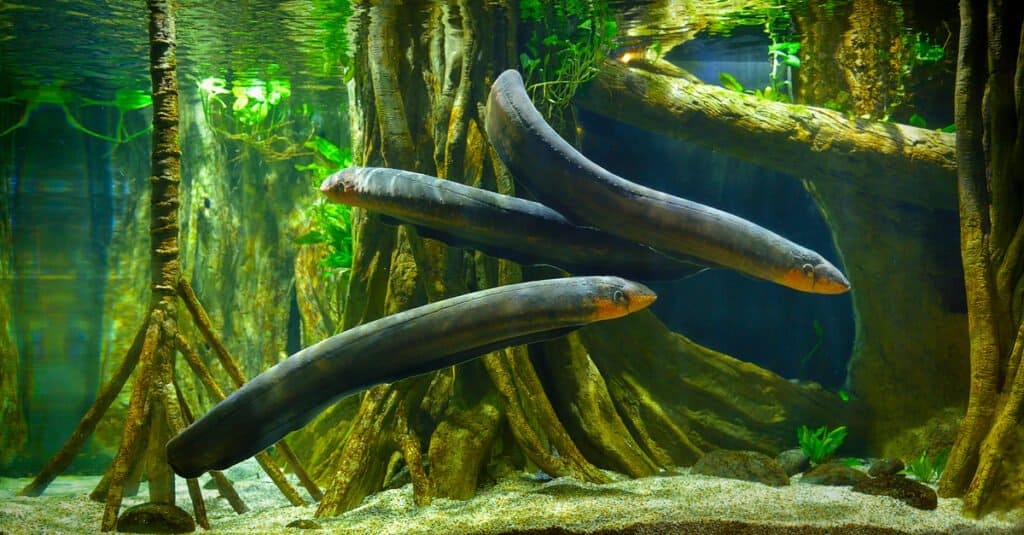
Electric Eels are not true eels and are classified completely separately.
©tristan tan/Shutterstock.com
There are over 800 species, including snake-like fish and true eels. Conger, electric, fire, and muraena are the most dangerous species. The conger and muraena have powerful jaws with sharp teeth strong enough to drag people, while several shocks from an electric eel can cause respiratory or heart failure in people with underlying heart issues. The fire eel has toxic skin.
Below you can find a comprehensive guide to every species of eel:
Suborder Protanguilloidei
Protanguilla (First Eel)
- Protanguilla palau
Suborder Synaphobranchoidei
Synaphobranchidae (Cutthroat Eels)
Atractodenchelys
- Atractodenchelys phrix (Arrowtooth Eel)
- Atractodenchelys robinsorum
Diastobranchus
- Diastobranchus capensis (Basketwork Eel)
Dysomma
- Dysomma anguillare (Shortbelly Eel)
- Dysomma brachygnathos
- Dysomma brevirostre (Batnose Eel)
- Dysomma bucephalus
- Dysomma dolichosomatum
- Dysomma formosa
- Dysomma fuscoventralis
- Dysomma goslinei
- Dysomma longirostrum
- Dysomma melanurum
- Dysomma muciparus
- Dysomma opisthoproctus
- Dysomma polycatodon
- Dysomma robinsorum
- Dysomma taiwanensis
- Dysomma tridens
Dysommina
- Dysommina proboscideus
- Dysommina rugosa
- Dysommina orientalis
Haptenchelys
- Haptenchelys parviocularis
- Haptenchelys texis
Histiobranchus
- Histiobranchus australis (Southern Cut-throat Eel)
- Histiobranchus bathybius (Deepwater Arrowtooth Eel)
- Histiobranchus bruuni (Bruun’s Cutthroat Eel)
Ilyophis
- Ilyophis arx
- Ilyophis blachei
- Ilyophis brunneus (Muddy Arrowtooth Eel)
- Ilyophis nigeli
- Ilyophis robinsae
- Ilyophis saldanhai
Linkenchelys
- Linkenchelys multipora
Meadia
- Meadia abyssalis (Abyssal Cutthroat Eel)
- Meadia roseni
- Meadia minor
Simenchelys
- Simenchelys parasitica (Snubnosed Eel)
Synaphobranchus
- Synaphobranchus affinis (Grey Cutthroat Eel)
- Synaphobranchus brevidorsalis (Shortdorsal Cutthroat Eel)
- Synaphobranchus calvus
- Synaphobranchus dolichorhynchus
- Synaphobranchus kaupii (Kaup’s Arrowtooth Eel)
- Synaphobranchus oregoni
Thermobiotes
- Thermobiotes mytilogeiton
Suborder Muraenoidei
Subfamily Muraeninae
Heterenchelyidae (Mud Eels)
Panturichthys
- Panturichthys fowleri
- Panturichthys isognathus
- Panturichthys longus
- Panturichthys mauritanicus
Pythonichthys
- Pythonichthys asodes
- Pythonichthys macrurus
- Pythonichthys microphthalmus
- Pythonichthys sanguineus
Myrocongridae (Thin Eels)
Myroconger
- Myroconger compressus (Red Eel)
- Myroconger gracilis
- Myroconger nigrodentatus (Orange Eel)
- Myroconger pietschi
- Myroconger prolixus
- Myroconger seychellensis
Muraenidae (Moray Eels)
Subfamily Muraeninae
Diaphenchelys
- Diaphenchelys pelonates (Mud-dwelling Moray)
Echidna
- Echidna amblyodon (Sulawesi Moray)
- Echidna catenata (Chain Moray)
- Echidna delicatula (Mottled Moray)
- Echidna leucotaenia (Whiteface Moray)
- Echidna nebulosa (Snowflake Moray)
- Echidna nocturna (Freckled Moray)
- Echidna peli (Pebbletooth Moray)
- Echidna polyzona (Barred Moray)
- Echidna rhodochilus (Pink-lipped Moray)
- Echidna unicolor (Pale Moray)
- Echidna xanthospilos (Yellow-spotted Moray)
Enchelycore
- Enchelycore anatina (Fangtooth Moray)
- Enchelycore bayeri (Hookjaw Moray)
- Enchelycore bikiniensis (Bikini Moray)
- Enchelycore carychroa (Caribbean Chestnut Moray)
- Enchelycore kamara (Dark-spotted Moray)
- Enchelycore lichenosa (Reticulate Hookjaw Moray)
- Enchelycore nigricans (Mottled Conger Moray)
- Enchelycore nycturanus
- Enchelycore octaviana (Slenderjaw Moray)
- Enchelycore pardalis (Dragon Eel)
- Enchelycore ramosa (Moasaic Moray)
- Enchelycore schismatorhynchus (White-margined Moray)
- Enchelycore tamarae
Enchelynassa
- Enchelynassa formosa (Viper Moray)
Gymnomuraena
- Gymnomuraena zebra (Zebra Moray
Gymnothorax
- Gymnothorax afer (Dark Moray)
- Gymnothorax albimarginatus (White-edged Moray)
- Gymnothorax andamanensis
- Gymnothorax angusticauda (Narrowtail Moray)
- Gymnothorax angusticeps (Wrinkled Moray)
- Gymnothorax annulatus (Ringed Moray)
- Gymnothorax atolli (Atoll Moray)
- Gymnothorax aurocephalus
- Gymnothorax australicola (South Pacific Moray)
- Gymnothorax austrinus (Southern Moray)
- Gymnothorax bacalladoi (Canary Moray)
- Gymnothorax baranesi
- Gymnothorax bathyphilus (Deep-dwelling Moray)
- Gymnothorax berndti (Berndt’s Moray)
- Gymnothorax breedeni (Blackcheek Moray)
- Gymnothorax buroensis (Latticetail Moray)
- Gymnothorax castaneus (Panamic Green Moray)
- Gymnothorax castlei (Castle’s Moray)
- Gymnothorax cephalospilus (Headspot Moray)
- Gymnothorax chilospilus (Lipspot Moray)
- Gymnothorax chlamydatus (Banded Mud Moray)
- Gymnothorax conspersus (Saddled Moray)
- Gymnothorax cribroris (Sieve-patterned Moray)
- Gymnothorax davidsmithi (Flores Mud Moray)
- Gymnothorax dorsalis
- Gymnothorax dovii (Speckled Moray)
- Gymnothorax elaineheemstrae
- Gymnothorax elegans (Elegant Moray)
- Gymnothorax emmae
- Gymnothorax enigmaticus (Enigmatic Moray)
- Gymnothorax equatorialis (Spotted-tail Moray)
- Gymnothorax eurostus (Abbott’s Moray)
- Gymnothorax eurygnathos
- Gymnothorax favagineus (Laced Moray)
- Gymnothorax fimbriatus (Fimbriated Moray)
- Gymnothorax flavimarginatus (Yellow-edged Moray)
- Gymnothorax flavoculus (Palenose Moray)
- Gymnothorax formosus
- Gymnothorax funebris (Green Moray)
- Gymnothorax fuscomaculatus (Brown-spotted Moray)
- Gymnothorax gracilicauda (Slendertail Moray)
- Gymnothorax griseus (Geometric Moray)
- Gymnothorax hansi
- Gymnothorax hepaticus (Liver-colored Moray)
- Gymnothorax herrei (Herre’s Moray)
- Gymnothorax hubbsi (Lichen Moray)
- Gymnothorax indicus
- Gymnothorax intesi (Whitetip Moray)
- Gymnothorax isingteena (Spotted Moray)
- Gymnothorax javanicus (Giant Moray)
- Gymnothorax johnsoni (White-spotted Moray)
- Gymnothorax kidako (Kidako Moray)
- Gymnothorax kolpos (Blacktail Moray)
- Gymnothorax kontodontos (Short-tooth Moray)
- Gymnothorax longinquus (Yellow-gilled Moray)
- Gymnothorax maderensis (Sharktooth Moray)
- Gymnothorax mareei (Spotjaw Moray)
- Gymnothorax margaritophorus (Blotch-necked Moray)
- Gymnothorax marshallensis (Marshall Islands Moray)
- Gymnothorax mccoskeri (McCosker’s Moray)
- Gymnothorax megaspilus (Oman Moray)
- Gymnothorax melanosomatus (Black-body Moray)
- Gymnothorax melatremus (Blackspot Moray)
- Gymnothorax meleagris (Turkey Moray)
- Gymnothorax microspila
- Gymnothorax microstictus
- Gymnothorax miliaris (Banana Eel)
- Gymnothorax minor (Lesser Moray)
- Gymnothorax mishrai
- Gymnothorax moluccensis (Moluccan Moray)
- Gymnothorax monochrous (Drab Moray)
- Gymnothorax monostigma (One-spot Moray)
- Gymnothorax mordax (California Moray)
- Gymnothorax moringa (Spotted Moray)
- Gymnothorax nasuta (Easter Island Moray)
- Gymnothorax neglectus
- Gymnothorax nigromarginatus (Blackedge Moray)
- Gymnothorax niphostigmus (Snowflake-patched Moray)
- Gymnothorax nubilus (Grey Moray)
- Gymnothorax nudivomer (Starry Moray)
- Gymnothorax nuttingi (Nutting’s Moray)
- Gymnothorax obesus (Speckled Moray)
- Gymnothorax ocellatus (Caribbean Ocellated Moray)
- Gymnothorax odishi
- Gymnothorax panamensis (Masked Moray)
- Gymnothorax parini
- Gymnothorax phalarus
- Gymnothorax phasmatodes (Ghost Moray)
- Gymnothorax philippinus
- Gymnothorax pictus (Painted Moray)
- Gymnothorax pikei (Pike’s Moray)
- Gymnothorax pindae (Pinda Moray)
- Gymnothorax polygonius (Polygon Moray)
- Gymnothorax polyspondylus (Manyvertebrae Moray)
- Gymnothorax polyuranodon (Freshwater Moray)
- Gymnothorax porphyreus (Lowfin Moray)
- Gymnothorax prasinus (Yellow Moray)
- Gymnothorax prionodon (Australian Mottled Moray)
- Gymnothorax prismodon (Sawtooth Moray)
- Gymnothorax prolatus
- Gymnothorax pseudoherrei (False Brown Moray)
- Gymnothorax pseudomelanosomatus
- Gymnothorax pseudothyrsoideus (Highfin Moray)
- Gymnothorax pseudotile
- Gymnothorax punctatofasciatus (Bars ‘n Spots Moray)
- Gymnothorax punctatus (Red Sea Whitespotted Moray)
- Gymnothorax randalli
- Gymnothorax reevesii (Reeve’s Moray)
- Gymnothorax reticularis (Reticulated Moray)
- Gymnothorax richardsonii (Richardson’s Moray)
- Gymnothorax robinsi (Robin’s Moray)
- Gymnothorax rueppelliae (Rüppell’s Moray)
- Gymnothorax ryukyuensis
- Gymnothorax sagenodeta
- Gymnothorax sagmacephalus
- Gymnothorax saxicola (Ocellated Moray)
- Gymnothorax serratidens
- Gymnothorax shaoi (Shao’s Moray)
- Gymnothorax sokotrensis
- Gymnothorax steindachneri (Brown Speckled Eel)
- Gymnothorax taiwanensis (Taiwanese Moray)
- Gymnothorax thyrsoideus (Greyface Moray)
- Gymnothorax tile (Indian Mud Moray)
- Gymnothorax undulatus (Undulated Moray)
- Gymnothorax unicolor (Brown Moray Eel)
- Gymnothorax vagrans
- Gymnothorax verrilli (White-edged Moray)
- Gymnothorax vicinus (Purplemouth Moray)
- Gymnothorax visakhaensis
- Gymnothorax walvisensis
- Gymnothorax woodwardi (Woodward’s Moray)
- Gymnothorax ypsilon (Y-bar Moray)
- Gymnothorax zonipectis (Barred-fin Moray)
Monopenchelys
- Monopenchelys acuta (Redface Moray)
Muraena
- Muraena appendiculata
- Muraena argus (White-spotted Moray)
- Muraena augusti
- Muraena clepsydra (Hourglass Moray)
- Muraena helena (Mediterranean Moray)
- Muraena lentiginosa
- Muraena melanotis (Honeycomb Moray)
- Muraena pavonina (Whitespot Moray)
- Muraena retifera (Reticulate Moray)
- Muraena robusta (Stout Moray)
Pseudechidna
- Pseudechidna brummeri (White Ribbon Eel)
Rhinomuraena
- Rhinomuraena quaesita (Ribbon Eel)
Strophidon
- Strophidon dorsalis
- Strophidon sathete (Slender Giant Moray)
Subfamily Uropterygiinae
Anarchias
- Anarchias allardicei (Allardice’s Moray)
- Anarchias cantonensis (Canton Island Moray)
- Anarchias euryurus
- Anarchias exulatus
- Anarchias galapagensis (Minute Moray)
- Anarchias leucurus (Snider’s Moray)
- Anarchias longicaudis
- Anarchias schultzi
- Anarchias seychellensis (Seychelles Moray)
- Anarchias similis (Pygmy Moray)
- Anarchias supremus
Channomuraena
- Channomuraena bauchotae
- Channomuraena vittata (Broadbanded Moray)
Cirrimaxilla
- Cirrimaxilla formosa (Taiwanese Barbel Moray)
Scuticaria
- Scuticaria okinawae (Shorttailed Snake Moray)
- Scuticaria tigrina (Tiger Moray)
Uropterygius
- Uropterygius concolor (Unicolor Snake Moray)
- Uropterygius cyamommatus
- Uropterygius fasciolatus (Blotched Moray)
- Uropterygius fuscoguttatus (Finless Moray)
- Uropterygius genie
- Uropterygius golanii
- Uropterygius inornatus (Drab Snake Moray)
- Uropterygius kamar (Moon Moray)
- Uropterygius macrocephalus (Needle-tooth Moray)
- Uropterygius macularius (Marbled Moray)
- Uropterygius marmoratus (Marbled Snake Moray)
- Uropterygius micropterus (Tidepool Snake Moray)
- Uropterygius nagoensis (Nago Snake Moray)
- Uropterygius oligospondylus
- Uropterygius polyspilus (Large-spotted Snake Moray)
- Uropterygius polystictus (Peppered Moray)
- Uropterygius supraforatus (Many-toothed Snake Moray)
- Uropterygius versutus (Two-holes Moray)
- Uropterygius wheeleri
- Uropterygius xanthopterus (Freckleface Reef Eel)
- Uropterygius xenodontus (Black Snake Moray)
Suborder Chlopsoidei
Family Chlopsidae (False Morays)
Boehlkenchelys
- Boehlkenchelys longidentata (Long-toothed False Moray)
Catesbya
- Catesbya pseudomuraena
Chilorhinus
- Chilorhinus platyrhynchus (Flatnose Xenocongrid Eel)
- Chilorhinus suensoni (Seagrass Eel)
Chlopsis
- Chlopsis apterus (Stripesnout False Moray)
- Chlopsis bicollaris (Bicolor False Moray)
- Chlopsis bicolor (Bicolored False Moray)
- Chlopsis bidentatus
- Chlopsis dentatus (Mottled False Moray)
- Chlopsis kazuko
- Chlopsis longidens
- Chlopsis nanhaiensis
- Chlopsis olokun
- Chlopsis orientalis
- Chlopsis sagmacollaris
- Chlopsis slusserorum
Suborder Congroidei
Family Derichthyidae (Longneck Eels)
Derichthys
- Derichthys serpentinus (Narrownecked Oceanic Eel)
Nessorhamphus
- Nessorhamphus danae (Dana Duckbill Eel)
- Nessorhamphus ingolfianus (Duckbill Oeanic Eel)
Family Ophichthidae (Snake Eels)
Subfamily Myrophinae
Ahlia
- Ahlia egmontis (Key Worm Eel)
Asarcenchelys
- Asarcenchelys longimanus
Benthenchelys
- Benthenchelys cartieri
- Benthenchelys indicus
- Benthenchelys pacificus
Glenoglossa
- Glenoglossa wassi
Mixomyrophis
- Mixomyrophis longidorsalis
- Mixomyrophis pusillipinna
Muraenichthys
- Muraenichthys gymnopterus
- Muraenichthys hattae
- Muraenichthys malabonensis
- Muraenichthys philippinensis (Phillipenes Worm Eel)
- Muraenichthys schultzei (Maimed Snake Eel)
- Muraenichthys sibogae (Siboga Worm Eel)
- Muraenichthys thompsoni (Thompson’s Snake Eel)
- Muraenichthys velinasalis
Myrophis
- Myrophis anterodorsalis (Longfin Worm Eel)
- Myrophis lepturus
- Myrophis microchir (Ordinary Snake Eel)
- Myrophis platyrhynchus (Broadnose Worm Eel)
- Myrophis plumbeus (Leaden Worm Eel)
- Myrophis punctatus (Speckled Worm Eel)
- Myrophis vafer (Pacific Worm Eel)
Neenchelys
- Neenchelys andamanensis
- Neenchelys buitendijki (Fintail Serpent Eel)
- Neenchelys cheni
- Neenchelys daedalus
- Neenchelys diaphora
- Neenchelys gracilis
- Neenchelys mccoskeri (McCosker’s Worm Eel)
- Neenchelys microtretus
- Neenchelys nudiceps
- Neenchelys parvipectoralis
- Neenchelys pelagica
- Neenchelys similis
Pseudomyrophis
- Pseudomyrophis atlanticus
- Pseudomyrophis frio
- Pseudomyrophis fugesae (Diminutive Worm Eel)
- Pseudomyrophis micropinna (Smallfin Worm Eel)
- Pseudomyrophis nimius
Pylorobranchus
- Pylorobranchus hearstorum
- Pylorobranchus hoi
Schismorhynchus
- Schismorhynchus labialis (Groove-jawed Worm Eel)
Schultzidia
- Schultzidia johnstonensis (Johnston Snake Eel)
- Schultzidia retropinnis (Fringe-lipped Worm Eel)
Scolecenchelys
- Scolecenchelys acutirostris (Sharpnose Worm Eel)
- Scolecenchelys aoki (Misaki Worm Eel)
- Scolecenchelys australis (Shortfinned Worm Eel)
- Scolecenchelys brevicaudata
- Scolecenchelys breviceps (Long-finned Worm Eel)
- Scolecenchelys castlei (Deepwater Big-eyed Worm Eel)
- Scolecenchelys chilensis
- Scolecenchelys cookei
- Scolecenchelys fuscapenis
- Scolecenchelys fuscogularis (Dark Throat Worm Eel)
- Scolecenchelys godeffroyi (Godeffroy)
- Scolecenchelys gymnota (Indo-Pacific Slender Worm Eel)
- Scolecenchelys iredalei
- Scolecenchelys laticaudata (Redfin Worm Eel)
- Scolecenchelys macroptera (Slender Snake Eel)
- Scolecenchelys nicholsae (Nichols’ Worm Eel)
- Scolecenchelys profundorum
- Scolecenchelys puhioilo
- Scolecenchelys robusta
- Scolecenchelys vermiformis
- Scolecenchelys xorae (Orangehead Worm Eel)
Skythrenchelys
- Skythrenchelys macrostoma (Large-mouth Angry Worm Eel)
- Skythrenchelys zabra (Angry Worm Eel)
Sympenchelys
- Sympenchelys taiwanensis (Taiwanese Worm Eel)
Subfamily Ophichthinae
Allips
- Allips concolor
Aplatophis
- Aplatophis chauliodus (Fangtooth Snake Eel)
- Aplatophis zorro (Snaggle-toothed Snake Eel)
Aprognathodon
- Aprognathodon platyventris (Stripe Eel)
Apterichtus
- Apterichtus anguiformis (Slender Finless Eel)
- Apterichtus ansp (Academy Eel)
- Apterichtus australis (South Pacific Snake Eel)
- Apterichtus caecus (European Finless Eel)
- Apterichtus dunalailai
- Apterichtus equatorialis (Equatorial Eel)
- Apterichtus flavicaudus (Orange Snake Eel)
- Apterichtus gracilis
- Apterichtus hatookai
- Apterichtus jeffwilliamsi
- Apterichtus kendalli (Western Atlantic Finless Eel)
- Apterichtus klazingai (Sharpsnout Snake Eel)
- Apterichtus malabar
- Apterichtus monodi
- Apterichtus moseri
- Apterichtus mysi
- Apterichtus nariculus
- Apterichtus orientalis
- Apterichtus succinus
Bascanichthys
- Bascanichthys bascanium (Sooty Eel)
- Bascanichthys bascanoides (Sooty Sand Eel)
- Bascanichthys ceciliae
- Bascanichthys congoensis
- Bascanichthys cylindricus (Round Sand Eel)
- Bascanichthys deraniyagalai (Indian Longtailed Sand Eel)
- Bascanichthys fijiensis
- Bascanichthys filaria
- Bascanichthys gaira
- Bascanichthys inopinatus
- Bascanichthys kirkii (Longtailed Sand Eel)
- Bascanichthys longipinnis
- Bascanichthys myersi
- Bascanichthys panamensis (Panama Sand Eel)
- Bascanichthys paulensis
- Bascanichthys pusillus
- Bascanichthys scuticaris (Whip Eel)
- Bascanichthys sibogae (Siboga Snake Eel)
Brachysomophis
- Brachysomophis atlanticus
- Brachysomophis cirrocheilos (Stargazer Snake Eel)
- Brachysomophis crocodilinus (Crocodile Snake Eel)
- Brachysomophis henshawi (Reptilian Snake Eel)
- Brachysomophis longipinnis
- Brachysomophis porphyreus
- Brachysomophis umbonis (Turret Snake Eel)
Caecula
- Caecula kuro
- Caecula pterygera (Finny Snake Eel)
Callechelys
- Callechelys bilinearis (Twostripe Snake Eel)
- Callechelys bitaeniata
- Callechelys catostoma (Black-striped Snake Eel)
- Callechelys cliffi (Sandy Ridgefin Eel)
- Callechelys eristigma (Spotted Ridgefin Eel)
- Callechelys galapagensis (Galapagos Ridgefin Eel)
- Callechelys guineensis (Shorttail Snake Eel)
- Callechelys leucoptera
- Callechelys lutea (Freckled Snake Eel)
- Callechelys maculatus
- Callechelys marmorata (Marbled Snake Eel)
- Callechelys muraena (Blotched Snake Eel)
- Callechelys papulosa (Blistered Snake Eel)
- Callechelys randalli
- Callechelys springeri (Ridgefin Eel)
Caralophia
- Caralophia loxochila (Slantlip Eel)
Chauligenion
- Chauligenion camelopardalis (Giraffe-spotted Snake Eel)
Cirrhimuraena
- Cirrhimuraena calamus (Fringed-lipped Snake Eel)
- Cirrhimuraena cheilopogon
- Cirrhimuraena chinensis
- Cirrhimuraena inhacae (Inhaca Fringelip)
- Cirrhimuraena oliveri
- Cirrhimuraena orientalis
- Cirrhimuraena paucidens
- Cirrhimuraena playfairii (Fringelip Snake Eel)
- Cirrhimuraena tapeinoptera
- Cirrhimuraena yuanding
Cirricaecula
- Cirricaecula johnsoni (Fringelip Snake Eel)
- Cirricaecula macdowelli
Dalophis
- Dalophis boulengeri
- Dalophis cephalopeltis
- Dalophis imberbis (Armless Snake Eel)
- Dalophis multidentatus
- Dalophis obtusirostris
Echelus
- Echelus myrus (Painted Eel)
- Echelus pachyrhynchus
- Echelus polyspondylus (Many-vertebrae Snake Eel)
- Echelus uropterus (Finned Worm Eel)
Echiophis
- Echiophis brunneus (Pacific Spoon-nose Eel)
- Echiophis intertinctus (Spotted Spoon-nose Eel)
- Echiophis punctifer (Stippled Spoon-nose Eel)
Ethadophis
- Ethadophis akkistikos (Indifferent Eel)
- Ethadophis byrnei (Ordinary Eel)
- Ethadophis epinepheli
- Ethadophis foresti
- Ethadophis merenda (Snack Eel)
Evips
- Evips percinctus (False Saddled Snake Eel)
Gordiichthys
- Gordiichthys combibus
- Gordiichthys ergodes (Irksone Eel)
- Gordiichthys irretitus (Horsehair Eel)
- Gordiichthys leibyi (String Eel)
- Gordiichthys randalli
Hemerorhinus
- Hemerorhinus heyningi (Molo Snake Eel)
- Hemerorhinus opici
Herpetoichthys
- Herpetoichthys fossatus (Mustachioed Snake Eel)
Hyphalophis
- Hyphalophis devius
Ichthyapus
- Ichthyapus acuticeps (Sharpnose Sand Eel)
- Ichthyapus insularis
- Ichthyapus keramanus
- Ichthyapus ophioneus (Surf Eel)
- Ichthyapus platyrhynchus
- Ichthyapus selachops (Smiling Snake Eel)
- Ichthyapus vulturis (Vulture Sand Eel)
Kertomichthys
- Kertomichthys blastorhinos
Lamnostoma
- Lamnostoma kampeni (Freshwater Snake Eel)
- Lamnostoma mindora
- Lamnostoma orientalis (Oriental Worm Eel)
- Lamnostoma polyophthalma (Ocellated Sand Eel)
- Lamnostoma taylori
Leiuranus
- Leiuranus semicinctus (Saddled Snake Eel)
- Leiuranus versicolor (Convict Snake Eel)
Leptenchelys
- Leptenchelys vermiformis (Slender Worm Eel)
Letharchus
- Letharchus aliculatus
- Letharchus rosenblatti (Sailfin Snake Eel)
- Letharchus velifer (American Sailfin Eel)
Lethogoleos
- Lethogoleos andersoni (Forgetful Snake Eel)
Leuropharus
- Leuropharus lasiops (Acned Snake Eel)
Luthulenchelys
- Luthulenchelys heemstraorum
Malvoliophis
- Malvoliophis pinguis (Halfband Snake Eel)
Myrichthys
- Myrichthys aspetocheiros (Longfin Spotted Snake Eel)
- Myrichthys breviceps (Sharptail Snake Eel)
- Myrichthys colubrinus (Harlequin Snake Eel)
- Myrichthys maculosus (Tiger Snake Eel)
- Myrichthys magnifies (Magnificent Snake Eel)
- Myrichthys ocellatus (Goldspotted Eel)
- Myrichthys paleracio (Whitenose Snake Eel)
- Myrichthys pantostigmius (Clarion Snake Eel)
- Myrichthys pardalis (Leopard Eel)
- Myrichthys tigrinus (Spotted Tiger Snake Eel)
- Myrichthys xysturus
Mystriophis
- Mystriophis crosnieri (Spoon-nose Eel)
- Mystriophis rostellatus (African Spoon-nose Eel)
Ophichthus
- Ophichthus alleni
- Ophichthus altipennis (Highfin Snake Eel)
- Ophichthus aniptocheilos
- Ophichthus apachus (Thin Snake Eel)
- Ophichthus aphotistos (Dark Deepwater Snake Eel)
- Ophichthus apicalis (Bluntnose Snake Eel)
- Ophichthus arneutes
- Ophichthus asakusae
- Ophichthus bicolor (Bicolored Snake Eel)
- Ophichthus bonaparti (Napoleon Snake Eel)
- Ophichthus brachynotopterus
- Ophichthus brasiliensis
- Ophichthus brevicaudatus
- Ophichthus brevirostris (Snubnose Snake Eel)
- Ophichthus celebicus
- Ophichthus cephalozona (Dark-shouldered Snake Eel)
- Ophichthus congroides
- Ophichthus cruentifer (Margined Snake Eel)
- Ophichthus cylindroideus (Dusky Snake Eel)
- Ophichthus echeloides
- Ophichthus erabo (Blotched Snake Eel)
- Ophichthus exourus
- Ophichthus fasciatus
- Ophichthus fowleri (Fowler’s Snake Eel)
- Ophichthus frontalis (Death-banded Snake Eel)
- Ophichthus genie
- Ophichthus gomesii (Shrimp Eel)
- Ophichthus grandoculis
- Ophichthus hirritus
- Ophichthus humanni
- Ophichthus hyposagmatus (Faintsaddled Snake Eel)
- Ophichthus ishiyamorum
- Ophichthus kunaloa
- Ophichthus lentiginosus
- Ophichthus leonensis
- Ophichthus limkouensis
- Ophichthus lithinus (Evermann’s Snake Eel)
- Ophichthus longicorpus
- Ophichthus longipenis
- Ophichthus machidai
- Ophichthus macrochir (Bigfin Snake Eel)
- Ophichthus macrops
- Ophichthus maculatus
- Ophichthus manilensis
- Ophichthus marginatus (Shorthead Snake Eel)
- Ophichthus mecopterus (Longarmed Snake Eel)
- Ophichthus megalops
- Ophichthus melanoporus (Blackpored Eel)
- Ophichthus melope (Black-pored Snake Eel)
- Ophichthus menezesi
- Ophichthus microstictus
- Ophichthus mystacinus
- Ophichthus naga (Deepwater Demonic Snake Eel)
- Ophichthus obtusus
- Ophichthus omorgmus (Dottedline Snake Eel)
- Ophichthus ophis (Spotted Snake Eel)
- Ophichthus polyophthalmus (Many-eyed Snake Eel)
- Ophichthus pullus
- Ophichthus puncticeps (Palespotted Eel)
- Ophichthus remiger (Punctuated Snake Eel)
- Ophichthus retrodorsalis
- Ophichthus rex (King Snake Eel)
- Ophichthus roseus
- Ophichthus rotundus
- Ophichthus rufus (Rufus Snake Eel)
- Ophichthus rugifer (Wrinkled Snake Eel)
- Ophichthus rutidoderma (Olive Snake Eel)
- Ophichthus serpentinus
- Ophichthus shaoi (Long-bodied Snake Eel)
- Ophichthus singapurensis
- Ophichthus spinicauda (Antillian Snake Eel)
- Ophichthus stenopterus
- Ophichthus tchangi
- Ophichthus tetratrema
- Ophichthus tomioi
- Ophichthus triserialis (Pacific Snake Eel)
- Ophichthus tsuchidae
- Ophichthus unicolor (Plain Snake Eel)
- Ophichthus urolophus (Manetail Snake Eel)
- Ophichthus vietnamensis
- Ophichthus woosuitingi
- Ophichthus zophochir (Yellow Snake Eel)
Ophisurus
- Ophisurus macrorhynchos
- Ophisurus serpens (Serpent Eel)
Paraletharchus
- Paraletharchus opercularis (Pouch Snake Eel)
- Paraletharchus pacificus (Sailfin Eel)
Phaenomonas
- Phaenomonas cooperae (Short-maned Sand Eel)
- Phaenomonas longissima
- Phaenomonas pinnata (Elastic Eel)
Phyllophichthus
- Phyllophichthus xenodontus (Flappy Snake Eel)
Pisodonophis
- Pisodonophis boro (Rice-paddy Eel)
- Pisodonophis cancrivorus (Longfin Snake Eel)
- Pisodonophis copelandi
- Pisodonophis daspilotus (Marble-toothed Snake Eel)
- Pisodonophis hijala
- Pisodonophis hoeveni (Hoeven’s Snake Eel)
- Pisodonophis hypselopterus
- Pisodonophis sangjuensis (Korean Snake Eel)
- Pisodonophis semicinctus
Quassiremus
- Quassiremus ascensionis (Blackspotted Snake Eel)
- Quassiremus evionthas (Galapagos Snake Eel)
- Quassiremus nothochir (Smallfish Snake Eel)
- Quassiremus polyclitellum
Rhinophichthus
- Rhinophichthus penicillatus
Scytalichthys
- Scytalichthys miurus (Short-tailed Viper Eel)
Stictorhinus
- Stictorhinus potamius
Suculentophichthus
- Suculentophichthus nasus (Red Sea Flappy Snake Eel)
Xestochilus
- Xestochilus nebulosus
Xyrias
- Xyrias chioui
- Xyrias guineensis
- Xyrias multiserialis (Speckled Snake Eel)
- Xyrias revulsus (Strict Snake Eel)
Yirrkala
- Yirrkala calyptra
- Yirrkala chaselingi
- Yirrkala fusca
- Yirrkala gjellerupi
- Yirrkala insolitus
- Yirrkala kaupii
- Yirrkala macrodon
- Yirrkala maculata
- Yirrkala misolensis (Misol Snake Eel)
- Yirrkala moluccensis
- Yirrkala moorei
- Yirrkala omanensis (Oman Snake Eel)
- Yirrkala ori
- Yirrkala tenuis (Thin Sand Eel)
- Yirrkala timorensis (Earthworm Sand Eel)
Family Muraenesocidae (Pike Congers)
Congresox
- Congresox talabon (Yellow Pike Conger)
- Congresox talabonoides (Indian Pike Conger)
Cynoponticus
- Cynoponticus coniceps (Red Pike Conger)
- Cynoponticus ferox (Guinean Pike Conger)
- Cynoponticus savanna (Guyana Pike Conger)
Gavialiceps
- Gavialiceps arabicus
- Gavialiceps bertelseni
- Gavialiceps javanicus (Duckbill Conger)
- Gavialiceps taeniola
- Gavialiceps taiwanensis
Muraenesox
- Muraenesox bagio (Commmon Pike Conger)
- Muraenesox cinereus (Daggertooth Pike Conger)
Oxyconger
- Oxyconger leptognathus (Shorttail Pike Conger)
Sauromuraenesox
- Sauromuraenesox vorax
Family Nettastomatidae
Facciolella
- Facciolella castlei
- Facciolella equatorialis (Dogface Witch Eel)
- Facciolella gilbertii
- Facciolella karreri
- Facciolella oxyrhyncha (Facciola’s Sorcerer)
- Facciolella saurencheloides
Hoplunnis
- Hoplunnis diomediana (Blacktail Pike Conger)
- Hoplunnis macrura (Freckled Pike Conger)
- Hoplunnis megista
- Hoplunnis pacifica (Silver Pike Conger)
- Hoplunnis punctata (Slender Duckbill Eel)
- Hoplunnis schmidti
- Hoplunnis sicarius
- Hoplunnis similis
- Hoplunnis tenuis (Spotted Pike Conger)
Nettastoma
- Nettastoma falcinaris
- Nettastoma melanurum (Blackfn Sorcerer)
- Nettastoma parviceps (Shortsnouted Sorcerer)
- Nettastoma solitarium (Solitary Duckbill Eel)
- Nettastoma syntresis
Nettenchelys
- Nettenchelys bellottii
- Nettenchelys dionisi
- Nettenchelys erroriensis
- Nettenchelys exoria
- Nettenchelys gephyra (Bridge Duckbill Eel)
- Nettenchelys inion
- Nettenchelys paxtoni
- Nettenchelys proxima
- Nettenchelys pygmaea (Pygmy Pike Conger)
- Nettenchelys taylori
Saurenchelys
- Saurenchelys cancrivora (Slender Sorcerer)
- Saurenchelys cognita (Longface Eel)
- Saurenchelys elongata
- Saurenchelys fierasfer (Blacktail Duckbill Eel)
- Saurenchelys finitima (Whitsunday Wire Eel)
- Saurenchelys gigas
- Saurenchelys lateromaculata
- Saurenchelys meteori
- Saurenchelys petersi
- Saurenchelys stylura (Pillar Wire Eel)
- Saurenchelys taiwanensis
Venefica
- Venefica multiporosa
- Venefica ocella
- Venefica proboscidea (Whipsnout Sorcerer)
- Venefica procera
- Venefica tentaculata
Family Colocongridae (Worm Eels)
Coloconger
- Coloconger cadenati
- Coloconger canina
- Coloconger eximia
- Coloconger giganteus (Giant Leptocephalus)
- Coloconger japonicus
- Coloconger maculatus
- Coloconger meadi
- Coloconger raniceps (Froghead Eel)
- Coloconger saldanhai
- Coloconger scholesi (Indo-Pacific Shorttail Conger)
Family Congridae (Congers)
Subfamily Bathymyrinae
Ariosoma
- Ariosoma anago (Silvery Conger)
- Ariosoma anagoides (Sea Conger)
- Ariosoma anale (Longtrunk Conger)
- Ariosoma balearicum (Bandtooth Conger)
- Ariosoma bauchotae
- Ariosoma coquettei
- Ariosoma dolichopterum
- Ariosoma fasciatum (Barred Conger)
- Ariosoma gilberti (Gilbert’s Garden Eel)
- Ariosoma howensis (Lord Howe Conger)
- Ariosoma kapala (Mottled Conger)
- Ariosoma major
- Ariosoma marginatum (Large-eye Conger)
- Ariosoma mauritianum (Blunt-tooth Conger)
- Ariosoma meeki
- Ariosoma megalops
- Ariosoma mellissii (Silver Eel)
- Ariosoma multivertebratum
- Ariosoma nigrimanum
- Ariosoma obud
- Ariosoma ophidiophthalmus
- Ariosoma opistophthalmum
- Ariosoma prorigerum (Slope Conger)
- Ariosoma sanzoi
- Ariosoma sazonovi
- Ariosoma scheelei (Tropical Conger)
- Ariosoma selenops
- Ariosoma sereti
- Ariosoma shiroanago
- Ariosoma sokotranum
Bathymyrus
- Bathymyrus echinorhynchus
- Bathymyrus simus
- Bathymyrus smithi (Maputo Conger)
Chiloconger
- Chiloconger dentatus (Shortsnout Conger)
- Chiloconger philippinensis
Kenyaconger
- Kenyaconger heemstrai
Parabathymyrus
- Parabathymyrus brachyrhynchus
- Parabathymyrus fijiensis
- Parabathymyrus karrerae
- Parabathymyrus macrophthalmus
- Parabathymyrus oregoni (Flapnose Conger)
- Parabathymyrus philippinensis
Paraconger
- Paraconger californiensis (Californian Conger)
- Paraconger caudilimbatus (Margintail Conger)
- Paraconger guianensis
- Paraconger macrops (Blackspot Conger)
- Paraconger notialis (Guinean Conger)
- Paraconger ophichthys
- Paraconger similis (Shorttail Conger)
Subfamily Congrinae
Acromycter
- Acromycter alcocki
- Acromycter atlanticus
- Acromycter longipectoralis
- Acromycter nezumi
- Acromycter perturbator
Bassanago
- Bassanago albescens (Hairy Conger)
- Bassanago bulbiceps (Swollen-headed Conger Eel)
- Bassanago hirsutus (Deepsea Conger)
- Bassanago nielseni
Bathycongrus
- Bathycongrus aequoreus
- Bathycongrus bertini
- Bathycongrus bleekeri
- Bathycongrus bullisi (Bullish Conger)
- Bathycongrus dubius (Dubious Conger)
- Bathycongrus guttulatus (Lined Conger)
- Bathycongrus longicavis
- Bathycongrus macrocercus
- Bathycongrus macrurus (Shorthead Conger)
- Bathycongrus nasicus
- Bathycongrus odontostomus (Toothy Conger)
- Bathycongrus parapolyporus
- Bathycongrus parviporus
- Bathycongrus polyporus
- Bathycongrus retrotinctus (Blackedge Conger)
- Bathycongrus thysanochilus (Conger Eel)
- Bathycongrus trilineatus
- Bathycongrus trimaculatus
- Bathycongrus unimaculatus
- Bathycongrus varidens (Largehead Conger)
- Bathycongrus vicinalis (Neighbor Conger)
- Bathycongrus wallacei (Longnose Conger)
Bathyuroconger
- Bathyuroconger albus
- Bathyuroconger dolichosomus
- Bathyuroconger fowleri
- Bathyuroconger hawaiiensis
- Bathyuroconger parvibranchialis
- Bathyuroconger vicinus (Large-toothed Conger)
Blachea
- Blachea longicaudalis
- Blachea xenobranchialis (Frillgill Conger)
Castleichthys
- Castleichthys auritus (Eared Conger)
Conger
- Conger cinereus (Longfin African Conger)
- Conger conger (European Conger)
- Conger erebennus
- Conger esculentus (Grey Conger)
- Conger macrocephalus
- Conger marginatus (Hawaiian Mustache Conger)
- Conger melanopterus
- Conger myriaster (Whitespotted Conger)
- Conger oceanicus (American Conger)
- Conger oligoporus
- Conger orbignianus (Argentine Conger)
- Conger philippinus
- Conger triporiceps (Manytooth Conger)
- Conger verreauxi (Southern Conger)
- Conger wilsoni (Cape Conger)
Congrhynchus
- Congrhynchus talabonoides
Congriscus
- Congriscus maldivensis
- Congriscus marquesaensis
- Congriscus megastomus
Congrosoma
- Congrosoma evermanni (Evermann’s Conger)
Diploconger
- Diploconger polystigmatus (Headband Conger)
Gnathophis
- Gnathophis andriashevi
- Gnathophis asanoi
- Gnathophis bathytopos (Blackgut Conger)
- Gnathophis bracheatopos (Longeye Conger)
- Gnathophis capensis (Southern Atlantic Conger)
- Gnathophis castlei (Castle’s Conger)
- Gnathophis cinctus (Hardtail Conger)
- Gnathophis codoniphorus
- Gnathophis grahami (Graham’s Conger)
- Gnathophis habenatus (Little Conger Eel)
- Gnathophis heterognathos
- Gnathophis heterolinea
- Gnathophis leptosomatus
- Gnathophis longicauda (Little Conger)
- Gnathophis macroporis (Largepore Conger)
- Gnathophis melanocoelus (Blackgut Conger)
- Gnathophis microps (Smalleye Conger)
- Gnathophis musteliceps
- Gnathophis mystax (Thinlip Conger)
- Gnathophis nasutus (Bignose Conger)
- Gnathophis neocaledoniensis
- Gnathophis nystromi
- Gnathophis parini
- Gnathophis smithi
- Gnathophis tritos
- Gnathophis umbrellabius (Umbrella Conger)
- Gnathophis xenica
Japonoconger
- Japonoconger africanus
- Japonoconger caribbeus
- Japonoconger sivicolus
Lumiconger
- Lumiconger arafura (Luminous Conger)
Macrocephenchelys
- Macrocephenchelys brachialis
- Macrocephenchelys brevirostris (Rubbernose Conger)
Promyllantor
- Promyllantor adenensis
- Promyllantor atlanticus
- Promyllantor purpureus
Pseudophichthys
- Pseudophichthys splendens (Purple-mouthed Conger)
Rhynchoconger
- Rhynchoconger ectenurus
- Rhynchoconger flavus (Yellow Conger)
- Rhynchoconger gracilior (Whiptail Conger)
- Rhynchoconger guppyi
- Rhynchoconger humbermariorum
- Rhynchoconger nitens (Bignose Conger)
- Rhynchoconger squaliceps
- Rhynchoconger trewavasae
Scalanago
- Scalanago lateralis (Ladder Eel)
Uroconger
- Uroconger drachi
- Uroconger erythraeus
- Uroconger lepturus (Slender Conger)
- Uroconger syringinus (Threadtail Conger)
Xenomystax
- Xenomystax atrarius (Twinpored Eel)
- Xenomystax austrinus
- Xenomystax bidentatus
- Xenomystax congroides (Bristletooth Conger)
- Xenomystax trucidans
Subfamily Heterocongrinae (Garden Eels)
Gorgasia
- Gorgasia barnesi (Barnes’ Garden Eel)
- Gorgasia cotroneii
- Gorgasia galzini (Speckled Garden Eel)
- Gorgasia hawaiiensis (Hawaiian Garden Eel)
- Gorgasia inferomaculata
- Gorgasia japonica (Pacific Spaghetti Eel)
- Gorgasia klausewitzi (Klausewitz’s Garden Eel)
- Gorgasia maculata (Whitespotted Garden Eel)
- Gorgasia naeocepaea (Freckled Garden Eel)
- Gorgasia preclara (Splendid Garden Eel)
- Gorgasia punctata (Dotted Garden Eel)
- Gorgasia sillneri
- Gorgasia taiwanensis (Sharp-nose Garden Eel)
- Gorgasia thamani
Heteroconger
- Heteroconger balteatus
- Heteroconger camelopardalis
- Heteroconger canabus (White-ring Garden Eel)
- Heteroconger chapmani
- Heteroconger cobra (Cobra Garden Eel)
- Heteroconger congroides
- Heteroconger digueti (Pale Green Eel)
- Heteroconger enigmaticus (Enigma Garden Eel)
- Heteroconger hassi (Spotted Garden Eel)
- Heteroconger klausewitzi (Galapagos Garden Eel)
- Heteroconger lentiginosus (Masked Garden Eel)
- Heteroconger longissimus (Brown Garden Eel)
- Heteroconger luteolus (Yellow Garden Eel)
- Heteroconger mercyae (Mercy’s Garden Eel)
- Heteroconger obscurus (Obscure Garden Eel)
- Heteroconger pellegrini (Mimic Garden Eel)
- Heteroconger perissodon (Black Garden Eel)
- Heteroconger polyzona (Zebra Garden Eel)
- Heteroconger taylori (Taylor’s Conger Eel)
- Heteroconger tomberua
- Heteroconger tricia (Tricia’s Garden Eel)
Suborder Moringuoidei
Family Moringuidae (Spaghetti Eels)
Moringua
- Moringua abbreviata (Short Worm Eel)
- Moringua arundinacea (Bengal Spaghetti Eel)
- Moringua bicolor (Bicolor Spaghetti Eel)
- Moringua edwardsi (Common Spagheti Eel)
- Moringua ferruginea (Rusty Spaghetti Eel)
- Moringua javanica (Java Spaghetti Eel)
- Moringua macrocephalus
- Moringua macrochir (Longfin Spaghetti Eel)
- Moringua microchir (Lesser Thrush Eel)
- Moringua penni (Penn’s Thrush Eel)
- Moringua raitaborua (Purple Spaghetti Eel)
Neoconger
- Neoconger mucronatus (Ridged Eel)
- Neoconger tuberculatus (Swollengut Worm Eel)
- Neoconger vermiformis (Smalleye Spaghetti Eel)
Suborder Saccopharyngoidei
Family Eurypharyngidae (Pelican Eels)
Eurypharynx
- Eurypharynx pelecanoides (Pelican Eel)
Family Saccopharyngidae (Gulper Eels)
Saccopharynx
- Saccopharynx ampullaceus
- Saccopharynx berteli
- Saccopharynx harrisoni
- Saccopharynx hjorti
- Saccopharynx lavenbergi (Whiptail Gulper)
- Saccopharynx paucovertebratis
- Saccopharynx ramosus
- Saccopharynx schmidti
- Saccopharynx thalassa
- Saccopharynx trilobatus
Family Monognathidae (Onejaw Gulpers)
Monognathus
- Monognathus ahlstromi (Paddletail Onejaw)
- Monognathus berteli
- Monognathus bertini
- Monognathus boehlkei
- Monognathus bruuni
- Monognathus herringi
- Monognathus isaacsi
- Monognathus jesperseni
- Monognathus jesse
- Monognathus nigeli
- Monognathus ozawai
- Monognathus rajui
- Monognathus rosenblatti
- Monognathus smithi
- Monognathus taningi
Family Cyematidae (Bobtail Snipe Eels)
Cyema
- Cyema atrum (Arrow Eel)
Neocyema
- Neocyema erythrosoma
Suborder Anguilloidei
Family Anguillidae (Freshwater Eels)
Anguilla
- Anguilla anguilla (European Eel)
- Anguilla annosa
- Anguilla australis (Short-finned Eel)
- Anguilla bengalensis (African Mottled Eel)
- Anguilla bicolor
- Anguilla borneensis (Borneo Eel)
- Anguilla breviceps
- Anguilla brevicula
- Anguilla celebesensis (Celebes Longfin Eel)
- Anguilla dieffenbachii (New Zealand Longfin Eel)
- Anguilla interioris (Highlands Long-finned Eel)
- Anguilla japonica (Japanese Eel)
- Anguilla luzonensis (Philippine Mottled Eel)
- Anguilla marmorata (Giant Mottled Eel)
- Anguilla megastoma (Polynesian Longfinned Eel)
- Anguilla mossambica (African Longfin Eel)
- Anguilla multiradiata
- Anguilla nebulosa (Mottled Eel)
- Anguilla obscura (Pacific Shortfinned Eel)
- Anguilla pachyura
- Anguilla pfeili
- Anguilla rectangularis
- Anguilla reinhardtii (Speckled Longfin Eel)
- Anguilla rostrata (American Eel)
- Anguilla rouxi
Family Serrivomeridae (Sawtooth Eels)
Serrivomer
- Serrivomer beanii (Bean’s Sawtooth Eel)
- Serrivomer bertini (Thread Eel)
- Serrivomer brevidentatus (Black Sawtoothed Eel)
- Serrivomer lanceolatoides (Short-tooth Sawpalate)
- Serrivomer garmani
- Serrivomer jesperseni (Crossthroat Sawpalate)
- Serrivomer samoensis (Samoa Sawtooth Eel)
- Serrivomer schmidti
- Serrivomer sector (Saw-tooth Snipe)
Stemonidium
- Stemonidium hypomelas
Family Nemichthyidae (Snipe Eels)
Avocettina
- Avocettina acuticeps (Southern Snipe Eel)
- Avocettina bowersii
- Avocettina infans (Avocet Snipe Eel)
- Avocettina paucipora
Labichthys
- Labichthys carinatus
- Labichthys yanoi (Yano’s Snipe Eel)
Nemichthys
- Nemichthys curvirostris (Boxer Snipe Eel)
- Nemichthys larseni
- Nemichthys scolopaceus (Slender Snipe Eel)
Eel FAQs (Frequently Asked Questions)
How do eels reproduce?
Eels reproduce by spawning.
Where do eels live?
It depends on the species, but they live in either salt or freshwater habitats of various sizes.
Is it safe to eat eel?
Yes, as long as it is properly prepared. Eel blood is toxic to humans and so needs proper cooking for the heat to destroy the protein compounds. The skin is also toxic in some species and so needs removal.
Is an eel a snake or a fish?
All eels are fish in spite of their snakelike bodies.
Do eels bite?
Yes, some eel species bite. Congers and muraena have small, sharp teeth with strong jaws that can be powerful enough to drag people.
Are Eels herbivores, carnivores, or omnivores?
Eels are Carnivores, meaning they eat other animals.
What Kingdom do Eels belong to?
Eels belong to the Kingdom Animalia.
What is an interesting fact about Eels?
Eels can be a mere few inches long to 13 feet!
What's the difference between eels and sea snakes?
The primary difference between eels and sea snakes is that sea snakes lack gills while eels are fish. In addition, the two types of animals have reproductive, diet, and habitat differences. While eels are found across the world’s oceans, there are no sea snakes in the Atlantic Ocean!
Thank you for reading! Have some feedback for us? Contact the AZ Animals editorial team.
Sources
- Wikipedia / Accessed December 16, 2020
- Ocean Conservancy / Accessed December 16, 2020
- Britannica / Accessed December 16, 2020
- New Scientist / Accessed December 16, 2020
- Animals / Accessed December 16, 2020
- Study / Accessed December 16, 2020
- Tankarium / Accessed December 16, 2020
- Fact File / Accessed December 16, 2020
- What De What / Accessed December 16, 2020
- Cuteness / Accessed December 16, 2020
- What Eats? / Accessed December 16, 2020
- eHow / Accessed December 16, 2020
- Independent / Accessed December 16, 2020
- US Department of Agriculture / Accessed December 16, 2020

